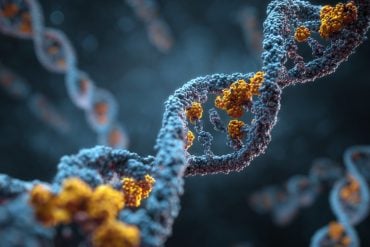Summary: Exposure to ultraviolet radiation type B increases levels of romantic passion in both men and women. The study reveals sunlight exposure affects the regulation of the endocrine system responsible for the release of sexual hormones in humans.
Source: Tel Aviv University
Researchers at Tel Aviv University have found that exposure to ultraviolet radiation from sunlight enhances romantic passion in humans. In the study both men and women were exposed to UVB (ultraviolet radiation type B) under controlled conditions, and the findings were unequivocal: increased levels of romantic passion in both genders.
The study revealed that exposure to sunlight affects the regulation of the endocrine system responsible for the release of sexual hormones in humans.
The study was led by PhD student Roma Parikh and Ashchar Sorek from the laboratory of Prof. Carmit Levy at the Department of Human Molecular Genetics and Biochemistry at the Sackler Faculty of Medicine. UVB phototherapy was administered to the subjects at the Tel Aviv Sourasky (Ichilov) and Assuta Medical Centers.
The groundbreaking discovery was published as a cover story in the prestigious scientific journal Cell Reports.
Prof. Levy explains: “It has been known for many years now that ultraviolet radiation from sunlight increases testosterone levels in males, and we also know that sunlight plays a major role in both the behavioral and hormonal regulation of sexuality. However, the mechanism responsible for this regulation remained unknown. Our study enabled a better understanding of this mechanism.”
The study began in an animal model, exposing the animals to UVB – sunrays at wavelengths of 320-400 nanometers. The effect was dramatic: females’ hormone levels rose significantly, enlarging their ovaries and prolonging their rut season; the attraction between males and females increased; and both were more willing to engage in sexual intercourse.
In the second stage, the researchers repeated the experiment in the animal model, this time removing from the skin a protein called p53, which identifies DNA damage and activates pigmentation during exposure to sunlight, as protection against its adverse effects.
The removal of p53 eliminated the effect of UVB exposure on the animals’ sexual behavior, convincing Prof. Levy and her colleagues that exposure to radiation through the skin was the cause of the observed hormonal, physiological and behavioral changes, and that the protective system is also responsible for the regulation of sexuality.
The last stage of the study included 32 human subjects, who filled out validated questionnaires on behaviors of romantic passion and aggression. Treated with UVB phototherapy at the Tel Aviv Sourasky (Ichilov) and Assuta Medical Centers, both genders exhibited a rise in romantic passion, and males also noted an increase in levels of aggression.
Similar results were found when the subjects were asked to avoid sunlight for two days, and then tan themselves for approximately 25 minutes. Blood tests revealed that exposure to sunlight resulted in a higher release of hormones like testosterone compared to one day before exposure.
A rise in testosterone in males during the summer was also found in analyses of data from the Clalit and Maccabi Health Services.
Prof. Levy: “The skin contains various mechanisms for dealing with radiation from sunlight, and one of these is the p53 protein. We must remember that exposure to UV is dangerous, and can damage the DNA, as in the case of skin cancer.

At the same time, two built-in programs in the skin, activated following exposure to sunlight, are in place to protect against DNA damage: the DNA repair system and pigmentation, namely the suntan, based on degree of exposure.
By activating both systems, the p53 protein regulates the level of DNA damage. In our study we found that the same system also activates the endocrine system of sexuality and potentially breeding. “
In the future this new discovery from TAU may lead to practical applications, such as UVB treatments for sexual hormone disorders. However, more research is still required before this can be achieved. According to Prof. Levy, the breakthrough will also lead to further discoveries in basic science.
“Our findings open many scientific and philosophical questions. As humans, we have no fur, and our skin is thus directly exposed to sunlight. We are only beginning to understand what this exposure does to us, and the key roles it might play in various physiological and behavioral processes. It’s only the tip of the iceberg.”
About this endocrinology research news
Author: Craig Jones
Source: Tel Aviv University
Contact: Craig Jones – Tel Aviv University
Image: The image is in the public domain
Original Research: Open access.
“Skin exposure to UVB light induces a skin-brain-gonad axis and sexual behavior” by Roma Parikh et al. Cell Reports.
Abstract
Skin exposure to UVB light induces a skin-brain-gonad axis and sexual behavior
Highlights
- •UVB exposure increases circulating sex-steroid levels in mice and humans
- •UVB exposure enhances female attractiveness and receptiveness toward males
- •UVB exposure increases females’ estrus phase, HPG axis hormones, and follicle growth
- •Skin p53 regulates UVB-induced sexual behavior and ovarian physiological changes
Summary
Ultraviolet (UV) light affects endocrinological and behavioral aspects of sexuality via an unknown mechanism.
Here we discover that ultraviolet B (UVB) exposure enhances the levels of sex-steroid hormones and sexual behavior, which are mediated by the skin. In female mice, UVB exposure increases hypothalamus-pituitary-gonadal axis hormone levels, resulting in larger ovaries; extends estrus days; and increases anti-Mullerian hormone (AMH) expression.
UVB exposure also enhances the sexual responsiveness and attractiveness of females and male-female interactions. Conditional knockout of p53 specifically in skin keratinocytes abolishes the effects of UVB.
Thus, UVB triggers a skin-brain-gonadal axis through skin p53 activation. In humans, solar exposure enhances romantic passion in both genders and aggressiveness in men, as seen in analysis of individual questionaries, and positively correlates with testosterone level.
Our findings suggest opportunities for treatment of sex-steroid-related dysfunctions.







